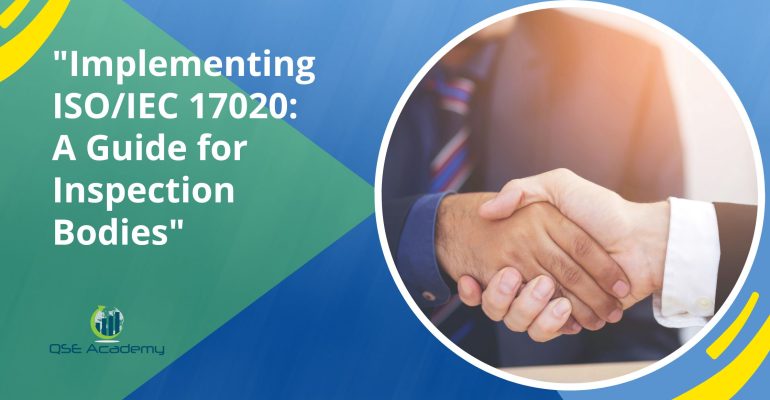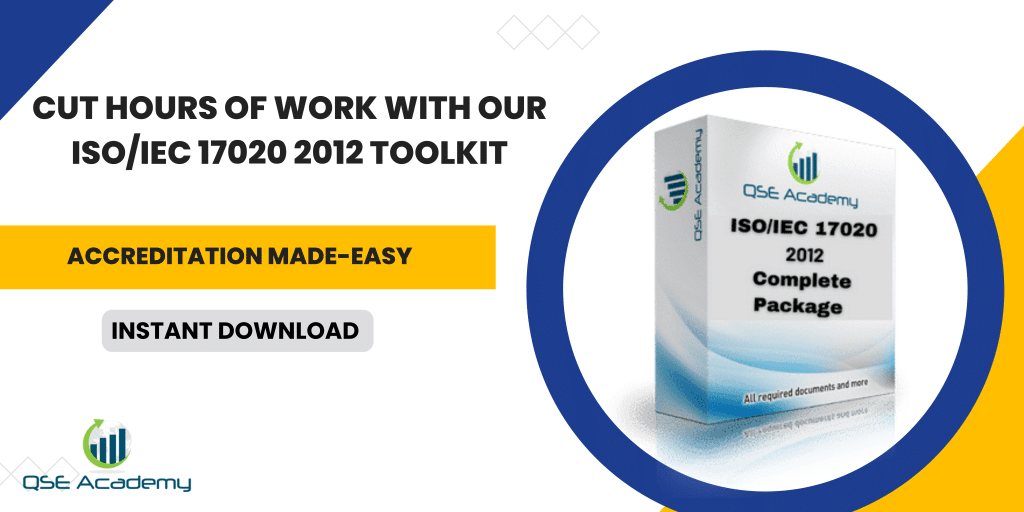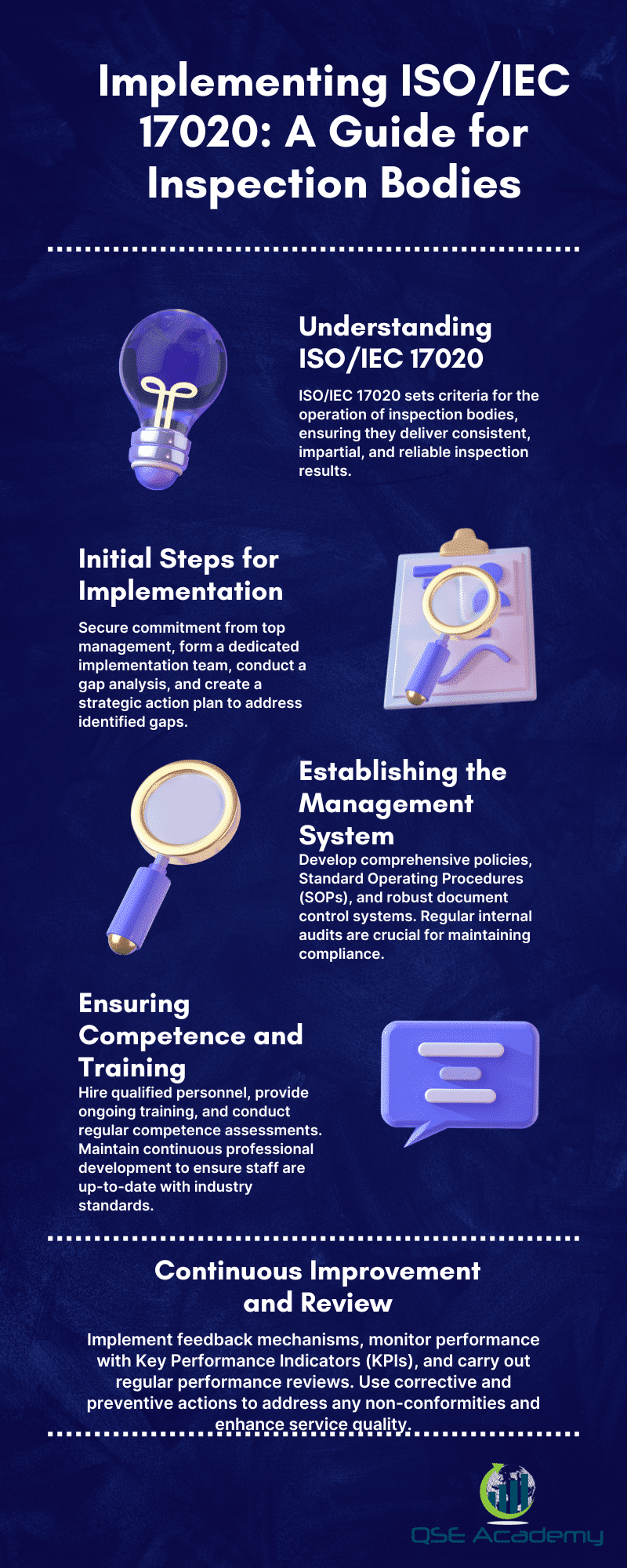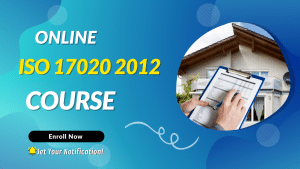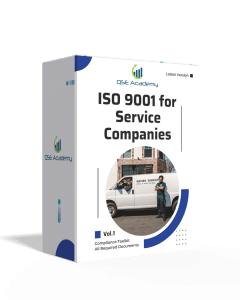Implementing ISO/IEC 17020: Inspection Bodies
Last Updated on October 22, 2025 by Hafsa J.
In a world that swears by quality, how do you stand apart? Conformity to international standards has become a hallmark of trust for inspection bodies. ISO/IEC 17020 represents a pinnacle for companies seeking to assure customers and stakeholders of their dedication to consistent, impartial, and competent inspection services.
This complex and rigorous standard is a roadmap for inspection bodies to demonstrate competency and reliability. It can be daunting, but with a structured approach, adapting ISO/IEC 17020 can become an integral part of an organization’s DNA. Ready to navigate the complexities of ISO/IEC 17020 and embed its principles into your operations?
The following article is your compass in this journey. It charts every necessary step, from grasping the core of ISO/IEC 17020, laying down initial preparation strategies, to assuring continuous advancements and drawing inspiration from the ones who’ve already succeeded. Prepare to transform your inspection body’s blueprint with this comprehensive guide to implementing ISO/IEC 17020.
Introduction
ISO/IEC 17020, formally known as ISO/IEC 17020:2012, sets forth criteria for the operation of various types of bodies performing inspection. This international standard is designed to ensure that inspection bodies operate with a high level of consistency and impartiality, guaranteeing credible and reliable inspection results. The purpose of implementing ISO/IEC 17020 is to elevate the quality and integrity of the inspection processes, a move that is essential for entities performing evaluations of products, services, or installations. For inspection bodies, adherence to ISO/IEC 17020 is not just about compliance; it signifies a commitment to excellence and competence, fostering trust with clients and stakeholders. By following the framework of standardized requirements, inspection bodies become part of an internationally recognized group capable of providing a high level of service across borders. This article aims to serve as an instructional guide for inspection bodies on the journey towards ISO/IEC 17020 implementation, providing a clear pathway to accreditation. Through concise paragraphs, we will navigate the various steps necessary to align with ISO/IEC 17020’s stringent standards, ensuring readiness for both national and international recognition.
Understanding ISO/IEC 17020
ISO/IEC 17020 is an internationally recognized standard for the competence of inspection bodies. It specifies requirements for the operation of various types of bodies performing inspection irrespective of the sector. The standard ensures that inspection services remain impartial and consistent, thereby enhancing confidence in the inspection results both within domestic markets and across international trade.
The primary objective of ISO/IEC 17020 is to ascertain that inspection bodies operate in such a manner that they ensure the integrity, impartiality, and reliability of their inspection activities. Implementing this standard involves adherence to vital principles such as confidentiality, independence, and a methodical approach.
ISO/IEC 17020 is crucial in industries where inspection is a key activity for safeguarding public health and safety, as well as ensuring compliance with regulations and standards. Examples include engineering, environmental health, forensic inspection, and statutory compliance.
To ensure that inspection services are both competent and impartial, ISO/IEC 17020 outlines the requirements for three types of inspection bodies:
- Type A: Totally independent in relation to the activities they inspect.
- Type B: A separate and identifiable part of an organization that carries out both inspections and other activities.
- Type C: The inspection body is part of an organization with activities other than inspection, but safeguards are in place to ensure impartiality.
The following table briefly outlines the differences between the inspection body types according to ISO/IEC 17020:
| Type of Inspection Body | Description | Independence Level |
| Type A | Independent entity with no conflict of interest in inspection activities | High |
| Type B | Performs inspections within their parent organization, also engaged in other activities | Moderate |
| Type C | Inspection is among several activities, with measures for impartiality | Basic |
Implementing the standard demands a commitment to these principles, focusing on the consistent application of inspections and the accuracy of results.
Initial Steps for Implementation
To embark on the ISO/IEC 17020 implementation journey, a concerted effort from the organization’s top management is imperative. Their commitment is the cornerstone of a successful rollout, as leadership support galvanizes the entire process, ensuring the necessary resources and priority. This aligns with the fact that without the upper echelon’s backing, vital decisions and changes might not be executed effectively.
The formation of a dedicated implementation team is equally crucial. Comprised of cross-departmental talents, this team becomes the torchbearer of the process, steering the system in accordance with ISO/IEC 17020 requirements. Their first task? Conducting a comprehensive gap analysis. This initial assessment delves into current operations, juxtaposing them with the international standard’s requisites. It is through this lens that the organization can identify gaps and areas begging for improvement.
Post-analysis, planning assumes center stage. Here, the team sets clear objectives and lays down pragmatic timelines—these serve as a navigational chart for the impending course of action. The carefully delineated plan naturally segues into resource allocation and budgeting, ensuring a well-equipped voyage towards compliance.
Timeline and Objectives:
| Milestone | Timeline (Months) |
| Gap Analysis Completion | 1-2 |
| Finalization of Objectives | 2-3 |
| Resource Allocation | 3-4 |
| Commencement of Trainings | 4-5 |
| Implementation of Changes | 5-6 |
As the table illustrates, the allocation of a straightforward and phased timeline is fundamental. This strategic approach not only fortifies the implementation effort but also makes the process less daunting and more manageable.
In summary, the initial steps for implementing ISO/IEC 17020 demand a fusion of resolute managerial support and strategic team action. Through gap analysis, objective setting, and strategic planning, the groundwork for commencing a structured implementation process is established.
Establishing the Management System
Implementing an effective management system under ISO/IEC 17020 involves developing comprehensive policies and procedures that will guide the operations of conformity assessment bodies. To start, it’s crucial to draft robust quality and operational policies. These documents form the cornerstone of the management system by setting the structure and intent for all subsequent activities.
Next, the crafting of detailed Standard Operating Procedures (SOPs) ensures standardized execution of tasks. SOPs offer step-by-step guidance to staff, promoting consistency and reliability in all operational facets. Effective SOPs are instrumental in achieving ISO/IEC 17020 compliance and in fostering confidence among stakeholders.
Central to maintaining an orderly management system is document control. This includes vigilant management of documentation and records, which is indispensable for traceability and accountability. To ensure integrity, a system for version control and access management is paramount. Staff should have access to current documents while also being safeguarded against unauthorized alterations.
Furthermore, the incorporation of internal audits into the management system acts as a self-check mechanism. Planning and conducting these audits assist in identifying areas for improvement. Addressing audit findings is a continuous process that promotes a culture of quality and enhancement.
| Key Component | Implementation Strategy |
| Policy Development | Draft clear quality and operational policies |
| SOP Creation | Create detailed SOPs for consistency |
| Document Control | Establish procedures for version control and manage access |
| Internal Audits | Regularly plan and perform audits and address findings |
By adhering to these steps, an organization ensures a solid foundation, ready to fulfill the stringent requirements of ISO/IEC 17020.
Ensuring Competence and Training
Implementing ISO/IEC 17020 within an organization requires steadfast attention to Section 4, which emphasizes the importance of ensuring competence and providing thorough training to personnel. Individuals involved in inspection activities must meet strict qualifications, underpinning the integrity and credibility of the inspection process.
Personnel Qualifications: Each employee’s qualification must align with their individual role, ensuring that they possess the necessary competences for their specific responsibilities. This is a foundational requirement of ISO/IEC 17020.
Defining Roles and Competencies: To maintain a high standard of inspection services, organizations must clearly define the roles and competencies required for their personnel. Role-specific expectations are set to ascertain that every task is executed by adequately skilled staff.
Hiring and Training Processes: The process of hiring should be designed to attract candidates with the requisite qualifications, followed by structured training programs that equip them for their inspection duties. Training must be both initial and continuous.
Continuous Professional Development and Ongoing Training: Personnel must engage in ongoing training and professional development to stay abreast of the latest industry standards and technologies. This ensures that their competence grows in tandem with the evolving sector.
Performance Evaluations and Feedback: Regular performance evaluations coupled with constructive feedback create an environment of continual improvement and skill enhancement.
Competence Assessment: Evaluating inspector competence is critical and should be conducted using robust methods that are both fair and comprehensive. Regular competency assessments ensure that inspectors are always capable of performing their tasks at the highest level.
Regular Reviews and Updates: To ensure sustained compliance with ISO/IEC 17020, organizations must regularly review and update their training programs to rectify any gaps in skills or knowledge.
In conclusion, adherence to Section 4 is pivotal for effective implementation of ISO/IEC 17020, with a well-defined framework for hiring, training, and assessing inspectors being essential for reliable inspection outcomes.
Conducting Inspections
Implementing ISO/IEC 17020 revolves around elevating inspection practices through standardization and procedural integrity. It ensures that the methods applied are both consistent and reliable.
Standardizing Inspection Methods:
Organizations must develop standardized inspection procedures, which form the bedrock of consistent service quality. This inclusively encompasses the appropriate utilisation of technologies and techniques, baking quality into the inspection process.
Handling Inspection Items:
On the frontline, the procedures for receiving and managing inspection items are critical. Consideration for maintaining the integrity and safety of the items is paramount. Staff must follow explicit guidelines to prevent damage or contamination, thereby safeguarding the accuracy of inspection results.
Sampling, Testing, and Measurement:
The inspection process extends to include sampling, testing, and measurement. Here, specific criteria must guide sampling: ensuring representativeness, avoiding cross-contamination, and ensuring every sample is treated consistently. The accuracy and reliability of measurements are non-negotiable, ensuring that data reflects true conditions without bias or error.
Here is a brief outline for easy reference:
- Standardized Procedures: Development and implementation of robust inspection procedures.
- Techniques and Technologies: Ensuring inspectors utilize appropriate and state-of-the-art methods.
- Handling Items: Establishment of protocols for item receipt and management to maintain their integrity and safety.
- Sampling and Testing Criteria: Clear guidelines that mandate sampling and testing procedures for accuracy.
- Measurement Reliability: Ensuring that each measurement taken during the inspection is reliable and accurate.
Through meticulous adherence to these elements, entities can align with ISO/IEC 17020. This standard offers a pathway to trustworthy inspection activities, ultimately contributing to heightened levels of consumer confidence and industry respect.
Reporting and Communication
Implementing ISO/IEC 17020 involves adhering to various standards, and Section 6 specifically addresses Reporting and Communication. This section demands that inspection reports be crafted with utmost attention to detail to guarantee clarity and completeness, ensuring that all relevant parties can understand the findings with ease.
Inspection Reports Content and Format Requirements The content and format of inspection reports are crucial for conveying findings effectively. Reports must contain sufficient information to understand both the inspection results and the basis upon which the conclusions were drawn. This includes a clear identification of the items inspected, the date of inspection, a summary of the inspection results, any conditions affecting the results, and the revealing of any non-conformity.
Clarity and Completeness To ensure clarity and completeness, reports should present data concisely and coherently. Details should be precise, with technical terms being used accurately to avoid confusion.
Communicating Findings Effectively communicating findings is fundamental to ISO/IEC 17020 compliance. This implies that reports should be promptly delivered to clients using agreed-upon methods, ensuring that communication is both timely and secure.
Effective Communication with Clients Maintaining an open line of dialogue, inspectors need to engage with clients transparently, articulating any issues or concerns that arose during the inspection. Client feedback should also be encouraged to foster ongoing improvement.
Providing Recommendations and Follow-up Actions While not compulsory, reports often include recommendations or suggested follow-up actions. When included, these should be presented unambiguously to facilitate client understanding and action.
Table – Essential Elements of an ISO/IEC 17020 Compliant Inspection Report:
| Element | Description | Purpose |
| Identification | Clearly state inspected items and inspection date | To attribute the report and results to a specific activity |
| Summary of Results | The outcome of the inspection, with details on any non-conformities | To communicate the findings and key observations succinctly |
| Recommendations | Any follow-up actions or corrections | To provide a pathway for continuous improvement or corrective action |
Inspection bodies must uphold these standards to retain credibility and effectiveness in their operations. The emphasis on clarity and completeness ensures that all stakeholders can make informed decisions based on the results presented within the inspection report.
Maintaining Impartiality and Confidentiality
To uphold the integrity and trust in inspection services, ISO/IEC 17020 specifies stringent policies to ensure impartiality and confidentiality. Organizations implementing ISO/IEC 17020 must demonstrate a solid commitment to these tenets, as they form the core of reliable inspection practices.
Policies for Impartiality
To prevent bias and ensure fair operations, entities must have robust policies that promote impartial decisions. These policies serve as a shield against any undue influence that could compromise the inspection outcomes. Inspectors must adhere to these principles, keeping professional judgment free from any conflict of interest.
Managing Conflicts of Interest
A systematic approach is necessary to identify and manage potential conflicts of interest. This involves regular reviews and staff declarations to highlight any situations that may pose a risk to impartiality. Vigilance in this area is crucial for maintaining the credibility of the inspection process.
| Area of Concern | Measures to Address |
| Independence of Inspections | Establish clear protocols ensuring that inspectors operate autonomously, without external pressures affecting their work. |
| Confidentiality | Enact strict guidelines to safeguard client data and sensitive information from unauthorized access or disclosure. |
Protecting Client Information
Inspectors are custodians of sensitive information and must treat it with the utmost discretion. Protecting client data isn’t just a policy issue; it’s also about building and maintaining trust with clients who expect confidentiality in their dealings.
Data Security Measures
In an age where data breaches are commonplace, implementing rigorous data security measures is non-negotiable. These steps might include secure data storage, encryption, controlled access, and regular audits to prevent unauthorized information exposure.
Each of these facets contributes to a larger framework designed to ensure that inspection services are carried out with integrity, independence, and confidentiality, aligning with the esteemed principles of ISO/IEC 17020.
Continuous Improvement and Review
ISO/IEC 17020 emphasizes the importance of continuous improvement and periodic review to ensure that inspection bodies maintain a high level of performance. To facilitate this, organizations should closely monitor and measure their performance, using relevant Key Performance Indicators (KPIs) as benchmarks.
Regular performance reviews and assessments are integral to the continuous improvement process. These assessments provide invaluable data on operational efficiency and service quality, which helps in setting the direction for strategic improvements.
Feedback mechanisms are vital for any organization looking to enhance its services. This includes actively gathering and using feedback from clients and stakeholders to inform the continuous improvement process. Such feedback can shine a light on potential areas of improvement and encourage proactive management of service delivery standards.
Corrective and preventive actions are instrumental in addressing any identified non-conformities within the operations. Whenever an issue is identified, it is essential to implement corrective measures promptly. Equally important is the development of preventive strategies to mitigate the risk of recurrence.
| Aspect | Method |
| Performance Monitoring | Regular reviews using KPIs. |
| Performance Assessment | Systematic evaluations & audits. |
| Feedback Gathering | Surveys, suggestion boxes, stakeholder meetings. |
| Corrective Actions | Root cause analysis, implementation of solutions. |
| Preventive Actions | Risk assessments, preemptive strategy formulations. |
Organizations can ensure continual advancement by embedding these practices within their operational culture. This cyclic process of performance review, feedback analysis, and the application of corrective and preventive actions not only assures compliance with ISO/IEC 17020 but also drives the organization toward excellence and robust service quality.
Conclusion
In conclusion, the implementation of ISO/IEC 17020 is pivotal for inspection bodies that aim to enhance their operational efficiencies, credibility, and market reputation. This standard sets a high benchmark for the competence of inspection services, fostering a culture of excellence and trust among stakeholders. The benefits are manifold; from ensuring consistent inspection protocols to increasing customer confidence, the operational gains to be had from adhering to ISO/IEC 17020 cannot be overstated.
Accreditation to this standard not only bolsters an organization’s standing but also encourages the adoption of a quality management system that is in perpetual motion towards improvement. Entities that achieve ISO/IEC 17020 accreditation demonstrate their relentless pursuit of excellence and their commitment to providing services that consistently meet the evolving needs of their customers.
For inspection bodies ready to elevate their services and operational effectiveness, pursuing ISO/IEC 17020 accreditation is a strategic move. It represents a dedication to quality that resonates throughout the organization and the market it serves. Continuous improvement and the regular updating of standards are integral to this process, ensuring that the benefits derived are both current and long-lasting.
Looking for More Resources on ISO 17020?
If you found this article helpful, explore our premium resources designed to help you achieve ISO 17020 certification efficiently:
- Complete Documentation Package for ISO/IEC 17020 2012: Get all the essential templates and documents you need for fast, easy implementation.
- Online Course on ISO/IEC 17020 2012 : Enroll in our comprehensive training to master the key concepts and practical steps toward certification.
- ISO/IEC 17020 2012 Checklist: Download our detailed checklist to ensure you’ve covered every step of the process.
These resources are tailored to meet your needs and ensure a smooth certification journey. Explore them today and get one step closer to success!

